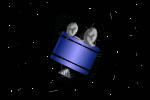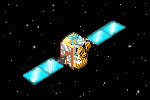DSCS III Satellite System Description
The DSCS III System provides super high frequency (SHF) satellite communications for the US Government and US military.
DSCS satellites provide secure communications for military command and control, intelligence and diplomatic traffic.
The Space and Missile Systems Center at Los Angeles Air Force Base is responsible for the space segment of DSCS.
The DSCS III satellite constellation has five prime operating locations. Originally intended for long haul strategic
communications, which utilize large fixed earth terminals; the future users of DSCS will be mobile forces, principally
Army and Navy. These users will principally be small and light mobile users.
The DSCS satellites have been and will be launched on a variety of launch vehicles. The Titan IIIC, Titan 34D, Space
Shuttle, Atlas II and EELV have or will be utilized. On the Altas II launch vehicle, the satellites require the
Integrated Apogee Boost Subsystem (IABS) developed by Lockheed Martin. The Inertial Upper Stage (IUS) was used on
previous launch vehicles to boost the DSCS satellites into their final orbit. There is more detailed information in the IABS section.
The last four remaining DSCS III satellites have been modified for the Service Life Enhancement Program (SLEP). The purpose of SLEP is
to enhance the performance of all six channels to a minimum level of 50 watts of the last four DSCS satellites. In conjunction with
this performance enhancement effort, each SLEP satellite will be modified with improved Low Noise Amplifiers (LNAs) which will minimize
the re-radiated noise from low Effective Isotropic Radiated Power (EIRP) uplink limited tactical users. Furthermore, satellites with
older bandwidth configurations (375 MHz) will be retrofitted with the Increased Bandwidth (IBW) modification (405 MHz) to make the
frequency plan consistent with the B8-B14 spacecraft. There is more detailed information in the SLEP section.
 |
 |
 |
1964 - 1973
Initial Defense
Communications
Satellite Program (IDSCP)
|
1969 - 1998
Defense Satellite
Communications
System II (DSCS II)
|
1976 - Present
Defense Satellite
Communications
System III (DSCS III)
|
Constellation Evolution
The DSCS Program started in the 1960's with the Initial Defense Communications Satellite Program
(IDSCP) built by Ford Aerospace and Communications (now Space Systems/Loral). Twenty-four satellites
each weighing about 45 kilograms was placed in 31,060-kilometer orbits. The satellite system relayed
voice, imagery, and digital data. The satellites provided communications including photo reconnaissance
imagery during the Vietnam War.
The DSCS II Program began in the 1970's with a dramatic increase in performance compared to IDSCP.
Built by TRW, each spin-stabilized satellite weighed about 545 kilograms and was placed in geostationary
orbit (approximately 37,000 kilometers). Each satellite had two twenty-two watt TWTAs covering four channels
and two horn and two parabolic dish antennas.
The DSCS III Program began in the 1980's with a contract to General Electric (now Lockheed Martin) to begin
production of the DSCS III satellites. The DSCS III satellites are better protected against the effects of
nuclear radiation and high power jammers. The DSCS III satellite also carries an AFSATCOM/Single Channel
Transponder (SCT) payload to disseminate the Emergency Action Message (EAM) to strategic nuclear forces.
The details of the DSCS III satellite are located under the "SLEP" section.
Communications Payload Parameters
The DSCS communications payload has eight antennas connected to via six communications channels. Each
channel has a limiter and amplifier and can be configured to support a variety of users. The satellite
antennas include four earth coverage horns, a 61 beam Multiple Beam Antenna (MBA) waveguide lens receive
antenna to provide jamming protection and two19 beam MBA waveguide lens transmit antennas to produce a
selected coverage beam pattern. For detailed specifications visit the SLEP section and view the specification tables.
|

